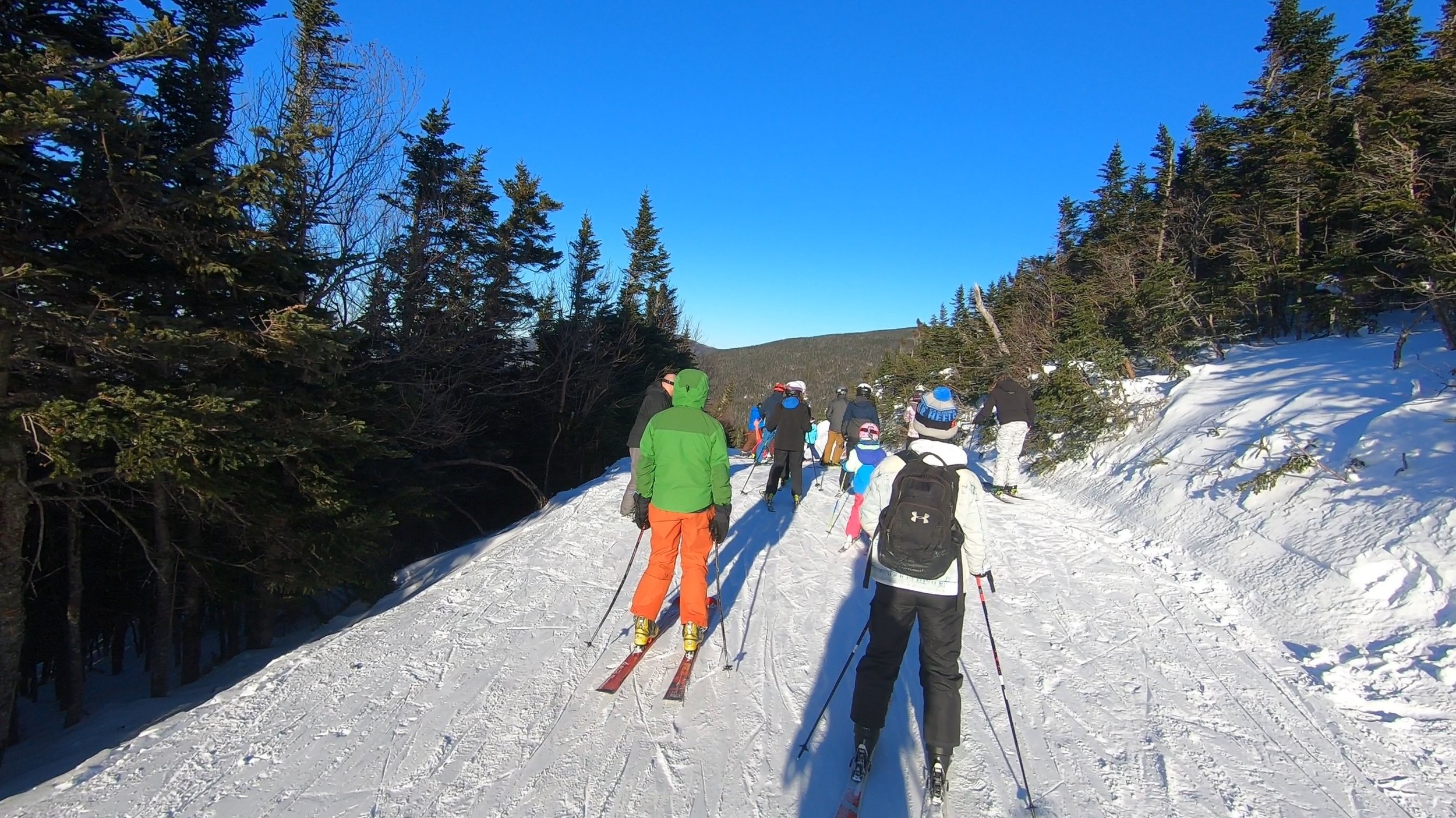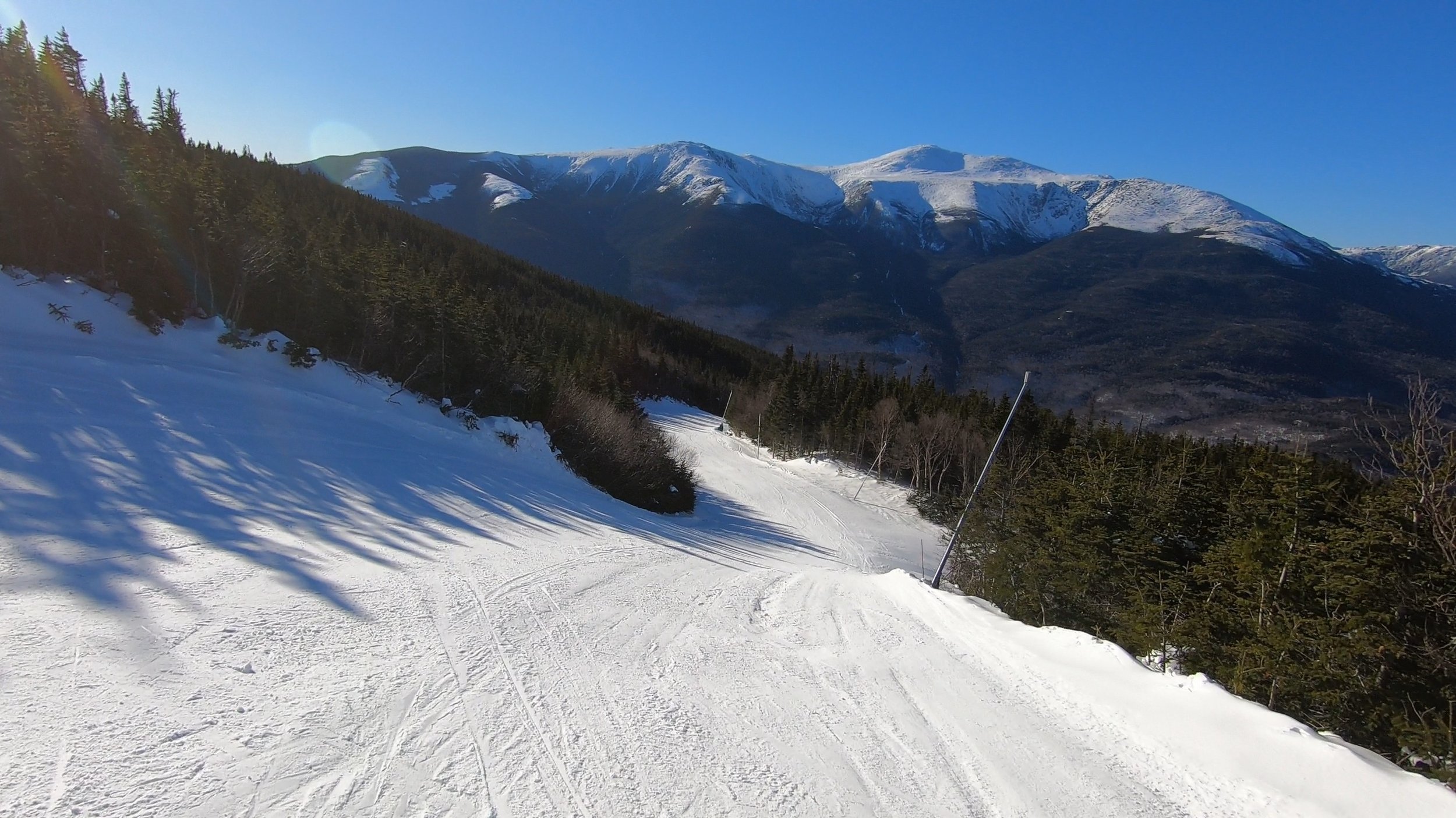Mountain Review: Wildcat
MOUNTAIN SCORE
CATEGORY BREAKDOWN
See our criteria5
Snow:
3
Resiliency:
2
Size:
4
Terrain Diversity:
6
Challenge:
7
Lifts:
6
Crowd Flow:
4
Facilities:
9
Navigation:
6
Mountain Aesthetic:
GOOD TO KNOW
1-Day Ticket: $69-$129
Pass Affiliation: Epic Pass
On-site Lodging: No
Après-ski: Limited
Nearest Cities: Boston (3 hrs), Montreal (3.5 hrs)
Recommended Ability Level:
+ Pros
Stunning Mount Washington views
Long, consistent vertical drop
Straightforward layout
– Cons
Profound wind exposure
Small footprint
No on-site lodging
MOUNTAIN STATS
Lifts: 5
Trails: 48
Beginner: 20%
Intermediate: 47%
Advanced/Expert: 33%
Mountain Review
Located just east of the iconic Mount Washington, Wildcat is one the most stunning ski resorts in New Hampshire, with in-your-face views of the Northeast’s tallest mountain from all parts of the ski area. Wildcat isn’t the largest ski resort out there, and its lack of on-site lodging means it won’t be attracting many folks looking for a fully-fledged ski resort experience, but it has a number of things going for it that keep it in the upper echelon of the New Hampshire ski resort scene.
Despite a small physical skiable footprint, the neighboring Mount Washington—which is the Northeast’s tallest mountain—gives Wildcat’s slopes an iconic look.
Size and Terrain Layout
With just a 225-acre footprint, Wildcat is quite a bit smaller than the most prominent East Coast destinations and more on par size-wise to the resorts in the southern part of the state. But Wildcat’s footprint is much taller than it is wide, and its 2,112-foot vertical drop is quite competitive for the East Coast. Wildcat also has one of the highest summit elevations in the Northeast, topping out just above 4,000 feet, which helps with snow preservation in upper mountain areas.
Wildcat’s layout is quite simple. The resort is really just one mountain face served in its full extent by the high-speed Wildcat Express Quad, with a range of helper fixed-grip lifts extending up part of the way. Whenever the summit quad goes on wind hold, the resort relies on the better-protected fixed-grip lifts for uphill service (although it’s very rare that the resort operates all of its lifts at the same time).
Wildcat’s sole upper-mountain green run, Upper Polecat, often gets extremely congested.
Beginner Terrain
Despite its small size and easy-to-navigate footprint, Wildcat is not the best resort for beginners. There’s only green trail down from the summit, and it often gets very congested. Each of the mid-mountain lifts offers access to green terrain as well, but they also only serve one trail each (and in the case of the Tomcat Triple lift, just provides a different point of access to the same top-to-bottom green run as the Wildcat Express Quad). Wildcat’s best beginner terrain is probably its learning area, which is held down by a triple lift and a magic carpet.
Wildcat offers some great intermediate groomers with fantastic Mount Washington views.
Intermediate Terrain
Wildcat becomes a more appealing mountain at the intermediate level. Nearly half of the resort’s footprint consists of intermediate cruiser terrain, with the largest concentration of this type of terrain in the lower half of the footprint. Only two intermediate trails exist down directly from the summit—and one of these involves a short stint on the over-congested Upper Polecat beginner run first—but these runs are among the most beautiful groomed ski trails in the state, offering some of the most imposing views of Mount Washington at the resort. A handful of blue runs usually remain ungroomed, making Wildcat a good resort to practice mogul terrain.
TRAIL MAP
Advanced and Expert Terrain
Wildcat perhaps stands out most for its advanced terrain. The resort maintains a decent pitch for its entire vertical descent, resulting in some long, demanding endurance runs. Wildcat rarely grooms its black-diamond runs, making the resort a great choice for those looking to test their limits on mogul terrain. While the resort lacks a double-black-diamond rating, a handful of Wildcat’s trails often have uncovered rocks or boulders, especially during the earlier months of the season.
The hardest runs extend right down the middle of the resort, maintaining advanced-level pitches for all but a brief section about two-thirds of the way down. And even in this mellower lower-mountain section, guests can find advanced-level glade terrain to keep the challenge going when conditions allow. Thanks to these circumstances, Wildcat is able to offer true top-to-bottom laps on ungroomed advanced terrain—something that few other ski resorts east of the Mississippi can claim.
Wildcat’s steep, consistent vertical descent makes for some of the best endurance runs in the East.
Backcountry Access
Wildcat is also home to some of the best lift-served backcountry terrain in the state of New Hampshire. Thompson Brook, a route directly accessible through a gate near the top of Upper Polecat, is home to awesome expert-level glade terrain, although this run is significantly more difficult than anything directly in-bounds and involves navigating a creek bed at the bottom. A few backcountry access gates a bit further down on Polecat provide steeper, alternate routes into this area. A few touring routes exist off the back side of Wildcat as well, though these trails are several miles long and end very far away from the lifts.
It’s important to note that these areas are not patrolled or maintained, so those who venture out of bounds should have proper backcountry training and rescue equipment. In addition, we’d highly recommend going with a partner for those who are unfamiliar with the area.
An extensive fleet of snowmaking guns, such as the one pictured top left, helps Wildcat maintain a consistent snow base throughout the ski season.
Snow Quality and Resiliency
With typical accumulation totals of just under 200 inches per year, Wildcat sees competitive snowfall for the state of New Hampshire. But the resort doesn’t see quite as much snow as some of the resorts further west in Vermont, meaning that the resort typically doesn’t enjoy the same natural base as that of the best East Coast mountains.
Wildcat employs a snowmaking system that covers a significant majority of its trails, ensuring a resilient base layer across the bulk of its footprint, even under less-than-ideal natural conditions. The mountain also does a great job of grooming its beginner and intermediate trails. However, several advanced-level runs have very inconsistent snowmaking—and a handful of trails, including all of the resort’s glades, have no snowmaking at all. These areas tend to suffer from thin-cover conditions and variable opening schedules for much of the season—and they typically do not open at all until mid-January.
RECOMMENDED SKIS FOR WILDCAT
NOTE: We may receive a small affiliate commission if you click on the below links. All products listed below are unisex.
Recommended all-mountain ski
Recommended carving ski
Recommended glade ski
Recommended expert/touring ski
Wind Exposure and Lift Closures
Perhaps Wildcat’s achilles heel is its wind exposure. In part due to its proximity to Mount Washington—which is notorious for having the highest average wind speeds of any location in the United States—Wildcat regularly sees profound wind gusts, especially in upper-mountain areas. These circumstances cause the mountain to regularly close down its Wildcat Express lift, often doing so multiple times per week. Unless the wind is especially bad, the resort does run its triple lifts when summit access isn’t an option; while these lifts do allow access to around half of Wildcat’s vertical drop, the already-small resort only has so much terrain to offer without the upper mountain. Before a visit to Wildcat, we’d highly recommend checking the wind speeds to ensure the whole mountain will be open.
Wildcat’s extremely wind-exposed upper mountain causes regular wind holds for its base-to-summit Wildcat Express Quad lift.
Crowds
Wildcat’s lift lines vary depending on the status of its upper mountain, but the resort doesn’t tend to get quite as crowded as its competitors further south. Modest lift lines do build up for the Wildcat Express Quad on busy days, with waits of 10-15 minutes common during peak times, while wait times are often similar (or perhaps just a bit shorter) on the mid-mountain triples when the high-speed quad is out of commission. Despite congestion on its limited beginner terrain, overcrowding on intermediate and advanced trails is much less of an issue.
Wildcat does see lift lines during peak times, but they aren’t as bad as the more conveniently-located resorts further south in the state.
On-Mountain Facilities
Wildcat is much more of a day-trip mountain than a true ski resort, and this circumstance is reflected in its on-mountain facility setup. The resort only has one base lodge, but it’s quite nice, with multiple floors and plenty of seating for the demand. And frankly, the resort is small enough that no matter where you are, it never takes too long to get down to this base complex.
Wildcat only has one lodge at the main base area, but it has multiple floors and plenty of space.
Epic Pass Access
It’s worth noting that Wildcat is on the Epic Pass, with unlimited access and no holiday blackouts on the Epic Pass, Epic Local Pass, and Northeast Value Pass products. For those who only plan to ski weekdays, Wildcat is also on the cheaper Northeast Midweek Pass.
Reciprocal Attitash Access
It’s also worth noting that a Wildcat lift ticket also gives you full access to nearby Attitash. While Attitash does not have the same vertical rise as Wildcat, its much more sheltered footprint can come in handy on days when Wildcat is too windy to fully operate. The drive between the two mountains typically takes just under half-an-hour.
RECOMMENDED SNOWBOARDS FOR WILDCAT
NOTE: We may receive a small affiliate commission if you click on the below links. All products listed below are unisex.
Recommended intermediate board
Recommended advanced board
Recommended expert board
Recommended touring board
Getting There and Parking
Wildcat is the northernmost major ski resort in the state of New Hampshire, and while still reasonably close, it’s the furthest drive from Boston as well, typically taking about three hours with no serious traffic. As a result, a drive to Wildcat from Boston takes just about as long as to the resorts of south-central Vermont. For those who choose to make the trek from New York, the drive typically takes around six-and-a-half hours, making the journey about equivalent in length to a trip to Vermont’s northernmost mountains. Wildcat also sits about three-and-a-half hours from the Canadian city of Montreal.
Like many other Northeast ski resorts, there is no public transportation to and from Wildcat. However, the resort offers free parking at all times, with one base area lot and two overflow lots.
While Wildcat has no on-site lodging, the resort is a five-minute drive from the Appalachian Mountain Club’s Joe Dodge Lodge (pictured above) and fairly close to a number of other options.
Lodging
Wildcat does not offer any lodging directly on site, but there are several options a short drive away. The closest accommodations are the Appalachian Mountain Club’s Joe Dodge Lodge, which sits at the trailhead for the infamous Tuckerman Ravine and offers reasonable prices for the value, and the Glen House, a fancy three-star hotel that offers great views of Mount Washington. A number of hotels, inns, and home rentals exist about 15 minutes away in the towns of Gorham and Jackson, while a much more extensive array of options sit around half-an-hour away in the town of North Conway.
Après-ski
Due in large part to its lack of a true base village, Wildcat’s après-ski scene is extremely limited. The resort does have a pub in its base lodge, but there really isn’t much to do after the slopes close.
Wildcat lacks a true base village, and après-ski is very limited.
Verdict
So Wildcat’s limited footprint size and significant wind exposure mean it won’t be a serious contender for East Coast destination-goers. But as a day-trip mountain for those who appreciate a combination of stunning views, a family-friendly setup, and demanding endurance runs, Wildcat is hard to beat.
Pricing
Wildcat’s lift ticket prices aren’t cheap, reaching well over $100 during peak times. However, they’re still quite a bit more reasonable than that of bigger resorts in Vermont. Those who want the best deal on access should be sure to secure an Epic Pass product before they’re off sale in early December.



























